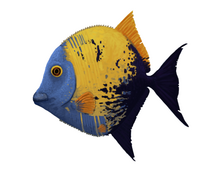| Thiollierepycnodus Temporal range: Kimmeridgian–Tithonian PreꞒ Ꞓ O S D C P T J K Pg N | |
|---|---|

| |
| Life reconstruction of Thiollierepycnodus wagneri | |
| Scientific classification | |
| Domain: | Eukaryota |
| Kingdom: | Animalia |
| Phylum: | Chordata |
| Class: | Actinopterygii |
| Order: | †Pycnodontiformes |
| Family: | †Pycnodontidae |
| Subfamily: | †Proscinetinae |
| Genus: | †Thiollierepycnodus Ebert (2020) |
| Species | |
| |
Thiollierepycnodus is an extinct genus of pycnodontid fish from the Jurassic of France and Germany. The animal was originally assigned to the genus Pycnodus, but it was given its own genus in 2020. Thiollierepycnodus was 25 cm long, with a laterally flat body and comparatively large fins, indicating that it was a reef fish of considerable manoeuvrability. Its durophagous dentition strongly suggests a diet of hard-shelled organisms. It contains a single species, Thiollierepycnodus wagneri.
Discovery and naming
The original specimens of Thiollierepycnodus were discorvered in Cerin, France, and, in 2014, new fossils of the genus were uncovered in Wattendorf, Germany. The fossil was originally described as Pycnodus wagneri by Victor Joseph de l’Isle Thiollière in 1852. The name of the species, P. wagneri, was in reference to Dr Johannes Andreas Wagner, a professor of zoology who lectured at the university in Munich.
In 1856, Heckel transferred the species to Microdon, a genus that turned out to be invalid, and was replaced by Proscinetes. In 1949, Saint-Seine referred to the species as Gyrodus, but though it didn't belong to that genus. In, 2002, Poyato-Ariza and Wenz referred to it as Proscinetes? wagneri. Martin Ebert, in 2020, erected the genus Thiollierepycnodus to replace P. wagneri.
The name Thiollierepycnodus is in refers to Thiollère, with the suffix "pycnodus" in reference to the genus it was originally assigned.
Description
Thiollierepycnodus had a total length of 25 cm, with a laterally compressed body and, without the fins, a contour resembling an almost perfect disc. Its dorsal and anal fins were large and had elongated fin rays.
Thiollierepycnodus, alongside Proscinetes, are the oldest pycnodontids discovered with complete skeletons. Older specimens are known only from isolated remains, mainly dentition.
Phylogeny
Thiollierepycnodus belonged in the subfamily Proscinetinae of the Pycnodontidae family, being a sister taxon to the Proscinetini tribe.
| Proscinetinae |
| ||||||||||||||||||||||||||||||||||||||||||||||||
References
- ^ Ebert, Martin (2020). "A new genus of Pycnodontidae (Actinopterygii) from the Upper Jurassic of France and Germany, included in a phylogeny of Pycnodontiformes". Zoological Journal of the Linnean Society. 188 (2): 434–454.
- Poyato-Ariza, Francisco (2015). "Studies on Pycnodontid fishes (I): Evaluation of their phylogenetic position among actinopterygians". Rivista Italiana di Paleontologia e Stratigrafia. 121 (3): 329–343.